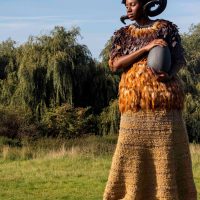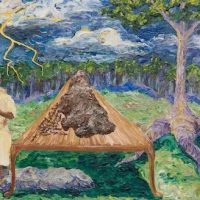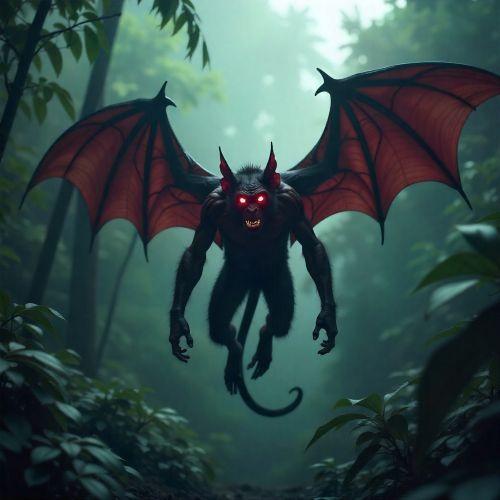Woyengi : The Creator Goddess
Listen
At a glance
| Description | |
|---|---|
| Origin | Ijaw Mythology |
| Classification | Gods |
| Family Members | N/A |
| Region | Nigeria |
| Associated With | Creation, Supreme Powers |
Woyengi
Introduction
Woyengi is the supreme creator goddess in the mythology of the Ijaw people of Nigeria, an ethnic group residing mainly in the Niger Delta region. Revered as both the creator of humanity and the goddess of destiny, Woyengi occupies a central place in Ijaw cosmology. According to myth, she descended from the heavens to the earth amid thunder and lightning, signifying divine authority and elemental power. Before her arrival, the world was inhabited by animals and plants but lacked human beings. Upon reaching earth, she molded the first humans from mud and breathed life into them, granting them consciousness and identity. She then offered them the power of choice—to select their gender, fortune, vocation, and even the manner of their death. These decisions defined each individual’s destiny, making Woyengi not only a creator but also a goddess of fate and free will. Her mythology expresses profound philosophical ideas about freedom, accountability, and the balance between divine law and human choice, themes that continue to shape Ijaw cultural and spiritual identity.
Physical Traits
Woyengi is rarely described in physical form, reflecting the Ijaw belief that divinity transcends human appearance. Instead, her presence is symbolized through natural phenomena—thunder, lightning, and the sacred iroko tree. Her descent to earth is marked by a flash of lightning and the sound of thunder, which announces her creative arrival. She is often depicted standing on a sacred creation stone before a large table and chair, molding the first human beings from earth’s mud. This imagery represents her dominion over the elements and her authority as the origin of all life. The use of natural symbols to describe her—earth, storm, and light—emphasizes her connection to creation and transformation. As a goddess associated with both nurturing and judgment, Woyengi embodies the dual forces of fertility and power that sustain the world. Her appearance in myth is less about form and more about presence—a manifestation of divine energy and creative intelligence guiding the birth of humanity.
Family
In Ijaw mythology, Woyengi stands as an autonomous, self-existing deity, often referred to as the “Great Mother.” Unlike deities in polytheistic pantheons that feature divine families or hierarchies, Woyengi’s origin is self-contained—she neither has parents nor a consort. She represents the primordial source of all creation and is considered the mother of humanity itself.
However, her interactions with her creations introduce familial and moral dimensions into her myth. The most significant of these is her relationship with Ogboinba, a woman created by Woyengi who later defied her authority. Ogboinba’s story highlights Woyengi’s role not only as a creator but also as a moral guardian and enforcer of cosmic order. When Ogboinba sought to change her chosen destiny and challenged Woyengi’s decree, the goddess punished her by stripping away her powers. This narrative illustrates a maternal yet strict relationship between the divine and the human—a reflection of Woyengi’s role as both mother and judge. Through these myths, the Ijaw people perceive Woyengi as the ultimate maternal figure—compassionate in creation yet unwavering in maintaining the order she established.
Other names
The name Woyengi originates from the Ijaw words Wo (our) and Yengi (mother), translating to “Our Mother.” This title captures both her nurturing aspect and her communal importance as the universal mother of all living beings. Across different Ijaw dialects, variations such as Woyingi or Woyengi-Kuro appear, each reflecting local interpretations of her divine authority. The name Tamara, meaning “Creator,” is also occasionally used, emphasizing her supreme creative role in bringing life and order to the world.
In addition to being known as the creator goddess, she is frequently described as the “Goddess of Destiny,” underlining her power to determine and oversee human fate. These various names and epithets demonstrate the depth of her divine identity—she is at once a life-giver, protector, and regulator of destiny. The reverence embedded in her titles shows how the Ijaw people perceive her not as a distant deity but as an intimate maternal presence who shapes every aspect of existence.
Powers and Abilities
Woyengi’s powers encompass creation, destiny, and the elemental forces of nature. As the origin of humanity, she is believed to have molded the first humans from the earth’s clay and infused them with life through her divine breath. Her creative act went beyond forming bodies—she granted humans autonomy, allowing them to define their own paths. Each person, upon creation, was given the freedom to choose their gender, blessings, and life’s direction. Once these choices were made, Woyengi sealed them, symbolizing the irrevocable nature of fate.
Her dominion extends over both natural and spiritual realms. The thunder and lightning that accompany her descent mark her as a goddess of cosmic power and balance. She commands natural forces, directs the sun and moon, and influences fertility, healing, and death. As the goddess of destiny, she records and enforces the life paths chosen by her creations, ensuring harmony in the moral and spiritual order of the world. Her justice is absolute; she rewards devotion and integrity while punishing rebellion and arrogance, as seen in her conflict with Ogboinba.
Woyengi’s powers also hold symbolic significance. The act of creation from mud connects her to the earth’s fertility, while her use of lightning and thunder represents divine transformation—the energy that brings form out of chaos. Through her control of creation and fate, Woyengi embodies both the nurturing and disciplinary aspects of divinity, uniting the roles of mother, lawgiver, and cosmic architect in a single, awe-inspiring figure.
Modern Day Influence
Woyengi’s legacy continues to resonate deeply within Ijaw culture, even as modern religious practices have evolved. Although many Ijaw people today identify as Christians, traditional reverence for Woyengi endures through oral storytelling, folklore, and ritual remembrance. Her mythology remains a vital element of Ijaw identity, teaching moral lessons about choice, consequence, and respect for divine order.
In literature and the arts, Woyengi’s story has been retold and reinterpreted to preserve her cultural importance. The Nigerian playwright Obotunde Ijimere adapted her myth in the acclaimed play Woyengi, exploring themes of creation, destiny, and rebellion. Scholars of African religion and philosophy continue to study her as a rare example of a female creator deity in world mythology, often referencing her as a symbol of feminine power and divine authority.
Beyond academic and artistic representation, Woyengi’s influence persists in local belief systems that emphasize balance between human choice and spiritual responsibility. The notion that individuals choose their own destiny before birth remains a central moral concept in Ijaw cosmology and is reflected in rituals surrounding birth, death, and community leadership. In contemporary discussions on gender and spirituality, Woyengi is celebrated as a powerful representation of the sacred feminine—an embodiment of creation, justice, and wisdom. Her myth endures as a guiding narrative that connects the Ijaw people to their ancestral heritage while continuing to inspire broader conversations about identity, autonomy, and destiny in African mythology.
Related Images
Source
Lewis, T. M. (2016, November 1). Woyengi | West African Ijo Deity & Mythology. Encyclopaedia Britannica. https://www.britannica.com/topic/Woyengi
TalkAfricana. (2022, May 14). Woyengi, the Creator Goddess of the Ijaw People of Nigeria. https://talkafricana.com/woyengi-the-creator-goddess-of-the-ijaw-people-of-nigeria/
Wikipedia contributors. (2024, March 11). Woyengi. Wikipedia. https://en.wikipedia.org/wiki/Woyengi
Assain Esseru. (n.d.). About Woyingi. WordPress. https://woyingi.wordpress.com/about-woyingi/
Scribd. (n.d.). Ijo Creation Myth: Woyengi [PDF]. https://www.scribd.com/presentation/498940889/Woyengi
TV Tropes contributors. (n.d.). Myth / Ijaw Mythology. TV Tropes. https://tvtropes.org/pmwiki/pmwiki.php/Myth/IjawMythology
Wikipedia contributors. (2004, April 21). Ijaw people. Wikipedia. https://en.wikipedia.org/wiki/Ijaw_people
Britannica. (2016, November 2). Woyengi. Retrieved from https://www.britannica.com/topic/Woyengi
Course Hero. (n.d.). Summary and Analysis of Obotunde Ijimere’s Woyengi. Retrieved from https://www.coursehero.com/file/236381699/SUMMARY-AND-ANALYSIS-OF-OBOTUNDE-IJIMERES-WOYENGIpdf/
Horniman Museum and Gardens. (2019, March 21). Stories of Woyingi. Retrieved from https://www.horniman.ac.uk/story/stories-of-woyingi/
Frequently Asked Questions
What is lorem Ipsum?
I am text block. Click edit button to change this text. Lorem ipsum dolor sit amet, consectetur adipiscing elit. Ut elit tellus, luctus nec ullamcorper mattis, pulvinar dapibus leo.
What is lorem Ipsum?
I am text block. Click edit button to change this text. Lorem ipsum dolor sit amet, consectetur adipiscing elit. Ut elit tellus, luctus nec ullamcorper mattis, pulvinar dapibus leo.
What is lorem Ipsum?
I am text block. Click edit button to change this text. Lorem ipsum dolor sit amet, consectetur adipiscing elit. Ut elit tellus, luctus nec ullamcorper mattis, pulvinar dapibus leo.
What is lorem Ipsum?
I am text block. Click edit button to change this text. Lorem ipsum dolor sit amet, consectetur adipiscing elit. Ut elit tellus, luctus nec ullamcorper mattis, pulvinar dapibus leo.
What is lorem Ipsum?
I am text block. Click edit button to change this text. Lorem ipsum dolor sit amet, consectetur adipiscing elit. Ut elit tellus, luctus nec ullamcorper mattis, pulvinar dapibus leo.







